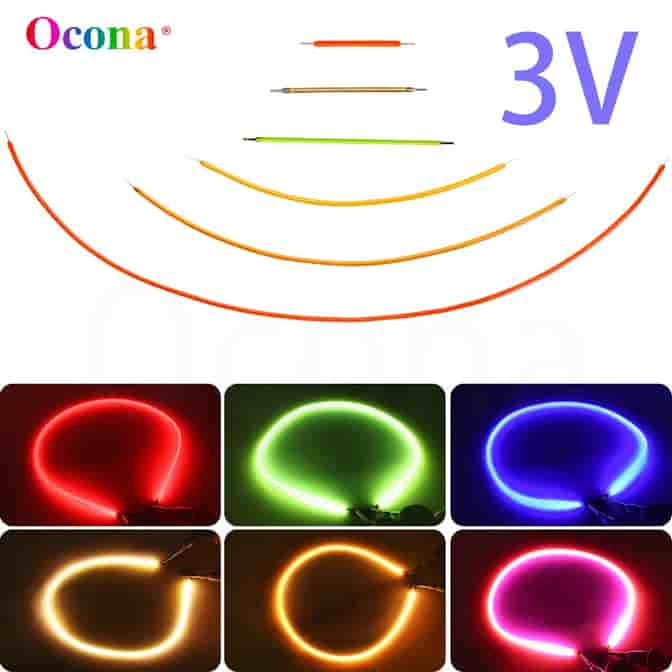Location
English- - -
- English
- Suomi
- Français
- Deutsch
- Ελληνικά
- Italiano
- 日本語
- Русский
- Español
- اللغة العربية
- Bahasa Melayu
- ภาษาไทย
- Filipino
- Bahasa Indonesia
- Norsk
- Svenska
- Dansk
- Português
- Čeština
- magya
- Polski
- limba română
Currency
- 0
Your cart is currently empty.
Continue shopping >
recently purchased
5-pack DC 3V Flexible LED Filament For LED Bulb DIY
Dimension: 38mm/60mm/80mm/130mm/185mm/300mm/600mm
$2.24
Get it between Jan 29 - Feb 11
Size :
Color :
Over 18 people have this in their bags right now.
DETAILS
Customers Reviews
The Ultimate Guide to LED Filament: Revolutionizing LED Edison Bulbs and DIY Projects
In the evolving world of LED technology, LED filaments have emerged as a game-changer, offering versatility and aesthetic appeal. Whether you’re an enthusiast looking to craft unique lighting solutions or a DIY hobbyist interested in creating something extraordinary, LED filaments are the perfect component to bring your ideas to life. This article dives deep into LED filaments, focusing on their applications, features, and how to best utilize them in your projects.
What is an LED Filament?
An LED filament is a slim, flexible strip that houses a series of high-density LEDs, enclosed within a soft, durable outer shell. With a diameter of just 1.8mm, these filaments are incredibly thin yet powerful. Commonly referred to as LED noodles, LED spaghetti, or simply nOOds, these components are widely used in LED bulbs, miniature craft projects, and even in electronics like Raspberry Pi and Arduino.
Key Features of LED Filaments
- Flexible Design: The flexibility of LED filaments allows them to be bent and shaped into various designs, making them ideal for creative DIY projects.
- Multiple Colors and Temperatures: Available in colors like blue, green, red, and warm white (2200K, 2700K), LED filaments can create the perfect ambiance for any setting.
- Variety of Lengths: These filaments come in various lengths, ranging from 30mm to 1200mm, providing ample options for different project needs.
- Low Voltage Operation: Operating on 2.8-3.2V DC, these filaments can be powered by a simple battery or any DC 3V power supply, making them versatile and easy to use.
Applications of LED Filaments
1. DIY LED Edison Bulbs LED filaments are perfect for DIY enthusiasts looking to create custom Edison bulbs. Their flexibility allows for the creation of intricate shapes, such as spirals, hearts, or even words, adding a personal touch to any lighting fixture.
2. Craft Projects These filaments are not just for lighting; they can also be used in various craft projects. From creating mini figures like lightsabers for Jedi-themed displays to innovative designs using Raspberry Pi or Arduino, the possibilities are endless.
3. Custom Lamps With LED filaments, you can design and construct unique lamps that stand out. Whether it’s a love-shaped lamp for a romantic ambiance or a spiral lamp for a modern touch, these filaments make it possible to bring your creative visions to life.
How to Use LED Filaments in Your Projects
Powering the Filaments LED filaments operate on low voltage, typically 2.8-3.2V DC. You can power them using batteries or other DC power supplies. It's crucial to note that power connections are on both ends of the filament—one end is positive (the one with the hole), and the other is negative. Always ensure that you're using a current-limiting resistor if required to avoid damaging the filament.
Soldering and Assembly As these filaments are DIY components, some assembly is required. This usually involves soldering the filaments to the power supply and adding the appropriate resistors for the voltage you're using. Although this may sound complicated, it’s a straightforward process with a bit of practice.
Designing Custom Shapes One of the most exciting aspects of LED filaments is the ability to bend and shape them. Whether you're crafting a spiral for a vintage Edison bulb or a heart shape for a custom lamp, the flexibility of these filaments makes it easy to create stunning designs.
Tips for Working with LED Filaments
- Use a Current Limiting Resistor: To prevent overheating or damage, always use a current-limiting resistor when powering your LED filaments.
- Plan Your Design: Before starting your project, sketch out your design to ensure you have the correct length and color of filament.
- Test Before Soldering: It’s wise to test the filament with a power supply before soldering to ensure it's functioning correctly.
Parameter:
Working Voltage: DC2.8~3.2V.
Dimension: 38mm/60mm/80mm/130mm/185mm/300mm/600mm, optional
Color: 2200K 2700K Red Blue Green Pink, optional
CRI: Ra80+
Power from 2 ends, the end with small hole is for +, the other is for -
Work temperature: -20~45°C
Not waterproof
Current limitation: Please use current limit resistor if needed
38mm <100mA
60mm <200mA
80mm <300mA
130mm<200mA
185mm<300mA
300mm<100mA
Package list:
5pcs LED Flame Filament
No reviews yet. Be the first to review this product
MAY YOU ALSO LIKE
Size Guide 


